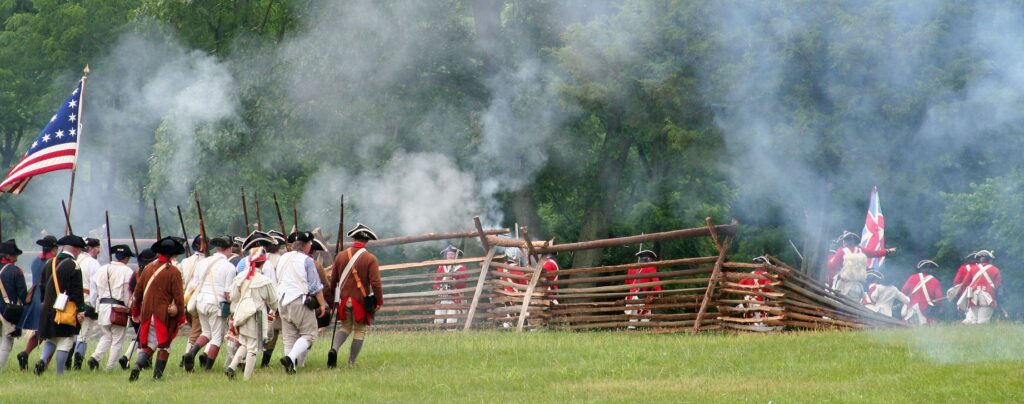
The American Revolution is a delight to study. A few tidbits from Edward Lengel and the contributing authors in The 10 Key Campaigns of the American Revolution are relevant to this blog. Some fun stuff:
- Perseverance in face of ongoing reversals.
- Paying Continental soldiers in specie, that means silver.
Next post will discuss What is a “militia?”
Paying Continental soldiers in specie, i.e. silver
Over the winter of 1780-1781 discontent in the army about not having been paid grew worse, reportedly resulting in either a near mutiny or open mutiny in January 1781. While marching troops from New York to contain Cornwallis at Yorktown, Washington borrowed about 20 million livres from the French to provide one months paid pay to the continental soldiers. Author says this is the only time troops were paid with silver.
Let’s ponder that amount of pay.
Wikipedia reports in the article French livre, currency was set at 8 ounces of silver equal to 51 lv, 2s, 3d. Let’s call that 51 livres to 8 ounces of silver. Doing a bit of math shows there are 6.38 livres to an ounce. That means one livre is 0.157 Troy ounces of silver.
For comparison, a pre-1965 U.S. quarter contains about 0.181 ounces of silver. Look at a modern quarter for a rough comparison to a French livre coin of the time. (Well, except there were no 1 lv coins minted, so picture a U.S. half dollar for a rough approximation of a 2 livre coin.)
The 20 million livres borrowed by Washington would be 3,137,255 ounces of silver. At 12 ounces to the troy pound that would be 261,438 Troy pounds.
This was an incredibly gracious loan by the French. Gen Rochambeau had a huge amount of silver with him as indicated by him being able to pay his troops and purchase all his applies in specie.
Author points out that this almost doubled the amount of specie, hard assets of silver and gold, in circulation across entire United States. That would have been a phenomenal boost to the entire economy at the moment and in the years to follow.
(Update 8/13/23: Just imagine the logistics and security issues faced by Gen. Rochambeau. He had enough silver to loan Washington 261,438 troy pounds – let’s ignore troy vs. avoirdupois issues and call that 260,000 pounds, or 130 tons. That was spare to what he needed to pay his troops every month or so and buy all his supplies. I’ll pull some numbers out of thin air and guess he started the campaign with 1,000 or 1,500 tons of silver. How do you guard that? How many troops does it take to watch the troops who are watching the silver? How do you move that securely and timely along with your troops while they are in the field. Wow.)
Perseverance in face of ongoing reversals.
Author points out George Washington had more losses in battle than wins. In spite of that he led the patriot forces to victory over the greatest world power of the time.
An overarching feature that shows throughout the book is perseverance in face of trials, tribulations, and battlefield defeats.
By December 25, 1776 things were going so poorly that the patriots thought the war for independence was already lost. Ten days later, after Washington’s crossing the Delaware and tremendous victory over the British at Trenton, hope revived.
The army almost fell apart at Valley Forge, but perseverance saw them through and General von Steuben provided the training that eventually let to Yorktown and victory.
Seems like the battles in the Carolinas were more often losses than wins, with a few spectacular exceptions.
In terms of perseverance, it is worth noting Major-General Nathanael Greene constantly struggled with “logistical difficulties, financial challenges, and three major battles.” His summary of the patriot forces in the south is reported to have been:
“We fight, get beat, rise, and fight again.”
It was only because of such perseverance in the face of severe challenges and reversals that the patriot forces gained our freedom.
What did all the patriot forces do?
Fight, lose, rally.
Fight, lose, rally.
Fight, lose, rally.
Fight, win.
We can all learn from their example.
2 thoughts on “Some tidbits from the American Revolution.”
Plus the British never fully committed to the war. I don’t think that is understood on our part.
Hi Ira:
They made a huge commitment. Just read a book and watched a documentary, both of which commented Howe’s arrival in New York was the largest armada in the Americas until the US sent troops off to WWI.
On your point, as a world empire, England also had to protect their territories in the Caribbean and stand ready to deal with France. They also had to garrison lots of other places. War was not overly popular at home which created recruiting problems, which put pressure on how many troops could be sent to the colonies.
Couple things I’ve read recently pointed out Howe alternated between pursing Washington hard and backing off. What if he had pushed harder? What if he did not wear dual hats as peace commissioner and commanding general tasked with putting down the rebellion?
Great point. Thanks for reading and commenting.
Jim